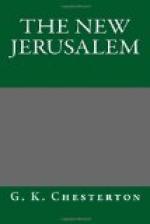For some days the city was really in a state of siege. If the snow had held for a sufficient number of days it might have been in a state of famine. The railway failed between Jerusalem and the nearest station. The roads were impassable between Jerusalem and the nearest village, or even the nearest suburb. In some places the snow drifted deep enough to bury a man, and in some places, alas, it did actually bury little children; poor little Arabs whose bodies were stiff where they had fallen. Many mules were overwhelmed as if by floods, and countless trees struck down as if by lightning. Even when the snow began at last to melt it only threatened to turn the besieged fortress into a sort of island. A river that men could not ford flowed between Jerusalem and the Mount of Olives. Even a man walking about the ordinary streets could easily step up to his knees or up to his waist. Snow stood about like a new system of natural barricades reared in some new type of revolution. I have already remarked that what struck me most about the city was the city wall; but now a new white wall stood all round the city; and one that neither friend nor foe could pass.
But a state of siege, whatever its inconveniences, is exceedingly convenient for a critic and observer of the town. It concentrated all that impression of being something compact and what, with less tragic attendant circumstances, one might call cosy. It fixed the whole picture in a frame even more absolute than the city wall; and it turned the eyes of all spectators inwards. Above all, by its very abnormality it accentuated the normal divisions and differences of the place; and made it more possible to distinguish and describe them like dramatis personae. The parts they played in the crisis of the snow were very like the parts they played in the general crisis of the state. And the very cut and colour of the figures, turban and tarbouch, khaki and burnous and gabardine, seemed to stand out more sharply against that blank background of white.
The first fact of course was a fact of contrast. When I said that the city struck me in its historic aspect as being at least as much a memory of the Crusaders as of the Saracens, I did not of course mean to deny the incidental contrasts between this Southern civilisation and the civilisation of Europe, especially northern Europe. The immediate difference was obvious enough when the gold and the gaudy vegetation of so comparatively Asiatic a city were struck by this strange blast out of the North. It was a queer spectacle to see a great green palm bowed down under a white load of snow; and it was a stranger and sadder spectacle to see the people accustomed to live under such palm-trees bowed down under such unearthly storms. Yet the very manner in which they bore it is perhaps the first fact to be noted among all the facts that make up the puzzling problem of Jerusalem. Odd as it may sound you can see that the true Orientals are




